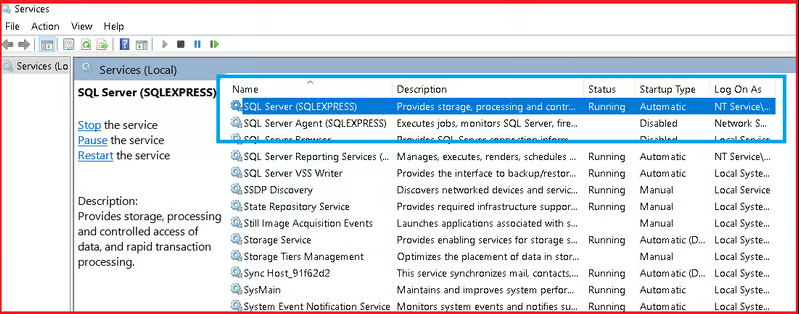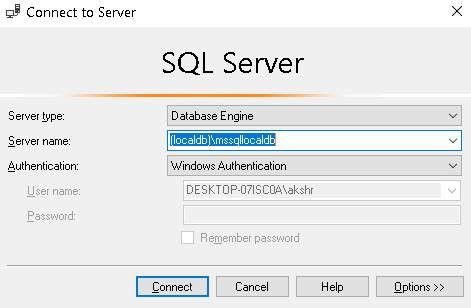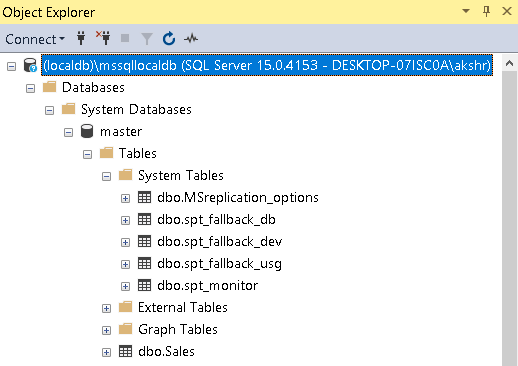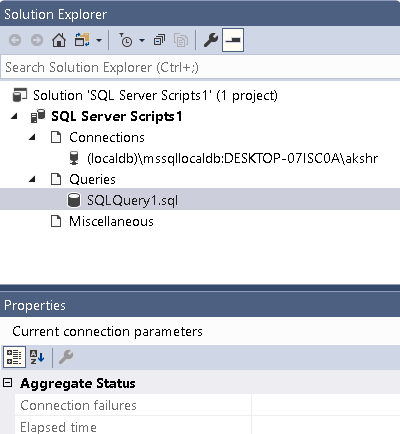Working professionals
Fresh graduates
- Study abroad
- Offline centres
More
1. SQL Tutorial
3. SQL Commands
5. SQL Aliases
10. SQL WHERE Clause
11. SQL AND Operator
13. SQL Like
16. MySQL Workbench
22. Index in SQL
24. Schema in SQL
31. SQL ORDER BY
38. NVL in SQL
41. SQL Wildcards
45. GROUP BY in SQL
46. SQL HAVING
47. EXISTS in SQL
48. SQL Joins
53. Self Join SQL
54. Left Join in SQL
57. Cursor in SQL
58. Triggers In SQL
61. REPLACE in SQL
63. Transact-SQL
64. INSTR in SQL
70. Advanced SQL
71. SQL Subquery
78. MySQL database
79. What is SQLite
80. SQLite
Mastering SQL Server Management Studio (SSMS): A Comprehensive Guide
Introduction
SQL Server Management Studio (SSMS) stands as the cornerstone tool for database administrators and developers alike in the realm of Microsoft SQL Server. In this comprehensive guide, we delve into the depths of SSMS, from installation and setup to advanced operations and best practices. Whether you're a seasoned database professional or a novice exploring the world of SQL Server, this guide will equip you with the knowledge and experience needed to harness the full potential of SQL Server Management Studio (SSMS).
Overview
SQL Server Management Studio (SSMS) serves as the central hub for administering and developing databases within the Microsoft SQL Server ecosystem. This guide provides a comprehensive overview of SSMS, covering its installation, essential features, and advanced functionalities. From connecting to servers and executing queries to performing database administration tasks and optimizing performance, SSMS offers a wealth of tools and capabilities. We'll explore best practices for utilizing SSMS effectively, troubleshooting common issues, and staying abreast of future developments in SQL Server management. Whether you're a DBA seeking to streamline operations or a developer aiming to enhance productivity, this guide equips you with the knowledge and observations to leverage SQL Server Management Studio (SSMS) proficiently.
Features of SQL Server Management Studio
SQL Server Management Studio (SSMS) is a complete tool for managing Microsoft SQL Server, offering a variety of features designed to facilitate database administration and development.
A. Graphical User Interface (GUI)
The GUI of SSMS is designed to be user-friendly, offering a structured and intuitive layout that allows users to manage their SQL Server instances efficiently. It includes menus, toolbars, and a workspace that organizes information and tools in a way that is easy to navigate.
Example: When you open SSMS, the main window displays the Object Explorer on the left, which lets you navigate through the servers, databases, and other SQL Server components. The central area typically opens with a Query Editor tab where SQL scripts are written and executed.
B. Object Explorer
Object Explorer is a critical component of SSMS that allows users to navigate, manage and view all objects in a SQL Server instance. This includes databases, tables, views, stored procedures, and security settings.
Example: To view details about tables in a database, you expand the server, then the database, and click on the "Tables" folder in Object Explorer. From here, you can right-click on any table to design, select the top 1000 rows, and modify or delete the table.
C. Query Editor
Query Editor is where SQL commands are written, edited, and executed. It provides syntax highlighting and IntelliSense (code completion features) to simplify writing and debugging SQL.
Example: To run a query that selects all records from a table called 'Employees,' you would open a new Query Editor window and type:
SELECT * FROM Employees;
Then, execute the query to see the results in the bottom panel of the Query Editor.
D. Activity Monitor
Activity Monitor is a tool within SQL Server Management Studio (SSMS) that provides information about SQL Server processes and how these procedures affect the current instance of SQL Server. This includes information about running processes, wait types, recent expensive queries, and more.
Example: To open Activity Monitor, right-click on server in Object Explorer and select "Activity Monitor." This view shows graphs and details of processor time, waiting tasks, database I/O, and more.
E. Database Engine Tuning Advisor
This tool analyzes the performance of SQL queries and provides recommendations on how to enhance them, potentially by adding indexes, partitioning tables, or other strategies.
Example: To use this tool, right-click on a database in Object Explorer, select 'Tasks,' then 'Database Engine Tuning Advisor.' Input queries to analyze or select a table to be the subject of the analysis.
F. Integration Services
Integration Services or SSIS, is a platform for creating enterprise-level data integration and data transformation solution. You can use SSIS to fix business problem complexity by copying or downloading files by updating data warehouses, sending email messages in response to events, cleaning and mining data, and managing SQL Server objects and data.
Example: Accessing and managing SSIS packages can be done through the "Integration Services Catalogs" node in Object Explorer.
G. Reporting Services
Reporting Services (SSRS) is a server-based report-generating software system from Microsoft. It is used to prepare and deliver a variety of interactive and printed reports.
Example: Reports can be managed and executed from the "Reporting Services" node in Object Explorer. This can involve deploying reports, configuring data sources, and setting security properties.
H. Analysis Services
Analysis Services (SSAS) provides online analytical processing (OLAP) and data-mining functionality for business intelligence applications. It allows users to analyze data with complex queries quickly.
Example: Through the "Analysis Services" node in Object Explorer, you can manage databases and cubes, process data, and set up roles and permissions.
Installation and Setup
We will explore SQL Server Management Studio (SSMS), a client tool used to connect to and interact with SQL Server. It's important to understand that SQL Server functions as server software within a client-server model, where the client sends requests that the server software processes and responds to. SSMS serves as this client tool, facilitating the management and operation of SQL Server. In this SSMS tutorial, through SSMS, we can manage various aspects of SQL Server, including user and security management, as well as query and interact with different database objects like system tables and user-defined tables, and execute stored procedures.
Before installing SQL Server Management Studio (SSMS), verifying that your system meets the minimum requirements to run the software efficiently is essential. These requirements can change slightly depending on the version of SSMS, but generally, they include:- Operating System: Windows 10 or later, or Windows Server 2016 or later.- Processor: 1.8 GHz or faster x86 (Intel, AMD) processor. Dual-core or better recommended.- RAM: Minimum of 2 GB of RAM (4 GB or more recommended).- Hard Disk: Minimum of 500 MB of available space.- .NET Framework: .NET Framework 4.8 or later is required. The most up-to-date system requirements are on the official Microsoft documentation page. For those just starting with this tool, our SSMS tutorial for beginners will guide you through these initial steps and beyond.
SSMS can be installed as a standalone application independent of any SQL Server installation. Here are the general steps for installing SSMS:
1. Download SSMS: Go to the official Microsoft download page for SQL Server Management Studio (SSMS) - https://learn.microsoft.com/en-us/sql/ssms/download-sql-server-management-studio-ssms?view=sql-server-ver16
2. Run the Installer: Once the download is complete, run the SSMS setup executable. You may need administrative privileges to go ahead with the installation.
3. Installation Wizard: It will guide you through the setup. Typically, it involves accepting the license terms, choosing the installation path, and proceeding.
4. Completion: After the installation finishes, you may need to restart your computer to complete the setup.
Connecting with SQL Server
First, ensure that an instance of SQL Server is active on your system, as SSMS can only connect if SQL Server is running. If the instance is not running, you will need to start it. You can verify whether an instance of SQL Server is running by checking the Services on your system. If it is not in a "Running" state, start the service. Once confirmed, open SSMS (SQL Server Management Studio) to initiate the connection.

When you run SSMS, the "Connect to Server" dialog box will appear. In this dialog box, you must enter the correct information into the various text fields to authenticate with SQL Server. Authentication is required because SQL Server is a secure system, and only authenticated users are allowed to log in.

When running SSMS, the "Connect to Server" dialog box requires you to enter the necessary connection details:
Server Type: Choose "SQL Server Database Engine" as the server type.
Server Name: Enter the server name you wish to connect to. This could be an IP address, a URL, or, for local systems, localhost or MSSQLLocalDB, depending on the SQL Server instance running on your system.
LocalDB: On my system, for example, an instance of SQL Server Express LocalDB is running. LocalDB is a feature of SQL Server Express, which can be selected during installation. It is intended for single-user access, and by default, only the instance owner can access it. The 'SqlLocalDB.exe' executable can be found in the 'C:\Program Files\Microsoft SQL Server\120\Tools\Binn' directory.
Authentication: SQL Server requires correct credentials for connection, offering different authentication modes:
1. SQL Server Authentication: This mode requires a valid username and password. It's a straightforward method where the user provides credentials.
2. Windows Authentication: Also known as "trusted connection," this mode uses the credentials of the currently logged-in Windows user, simplifying the login process as you don’t need to enter additional username or password. This is particularly seamless on personal computers. However, in a corporate environment using Active Directory, the administrator may need to configure user groups and permissions to facilitate access.
3. Mixed Mode Authentication: This option allows for the use of either SQL Server Authentication or Windows Authentication, depending on the situation. Note that if the SQL Server instance is not running, attempting to connect will result in a failure, and an error message will be displayed.

After logging in, the first step is to familiarize yourself with the objects available in SQL Server. SSMS features the Object Explorer window, which allows you to view any object on the server. If the Object Explorer is not visible, you can open it by pressing F8. The Object Explorer window, in SQL Server Management Studio, appears as shown below.

Session in SSMS
When SSMS connects to the SQL Server, a session is created to log in. This session terminates when the user closes SSMS.
Running SQL Script in SSMS
Running SQL scripts is a fundamental skill in SSMS. To open a new SQL Query editor window, press CTRL + N or click the "New Query" button in the Menu Bar. In the editor, you can write a test script such as 'SELECT * FROM INFORMATION_SCHEMA.TABLES' and execute the script by pressing F5 or CTRL+E. Alternatively, you can use the "Execute" button. Ensure that the relevant database is selected from the dropdown menu before running a script. In this example, the master database is selected.

Execution Plan of a Query
A crucial skill in SSMS is understanding how to obtain the execution plan of a query. To view the execution plan, press CTRL + L. The resulting execution plan for the query will appear below.

Query Options
Query options in SSMS can be configured by clicking the 'Query Options' button in the Menu Bar or navigating through Query > Query Options.

On clicking Query Options, you get the Query Options dialog box and you can used it to set the result or set ANSI settings, etc.

Creating Projects in SSMS
To create a new project in SQL Server Management Studio (SSMS) or SQL Management Studio, press CTRL+SHIFT+N. You can view and manage all projects in the Solution Explorer. An SQL Server script project includes connections, queries, and many other objects. You can create multiple script files within a single project.

Troubleshooting and Support
Troubleshooting and obtaining support for SQL Server Management Studio (SSMS) involves understanding common issues, utilizing learning resources, and engaging with support channels and communities. Here’s a detailed breakdown:
A. Common Issues and Resolutions
1. Connection Issues: A common problem is the inability to connect to the SQL Server instance. This can be due to network issues, SQL Server service not running, incorrect login credentials, or firewall settings blocking the connection.
- Resolution: Verify that the SQL Server service is running, check network connectivity, ensure correct credentials are used, and confirm that the firewall allows traffic on the SQL Server port (default is 1433 for TCP/IP).
2. Performance Problems: Users might experience slow performance when executing queries or loading large amounts of data.
- Resolution: Optimize queries with proper indexing, use the Database Engine Tuning Advisor to analyze and improve performance, and ensure sufficient system resources are available.
3. Permission Errors: Errors related to insufficient permissions for performing certain tasks.
- Resolution: Make sure the user account has the necessary permissions for the actions they are attempting to perform. This may require adjustments by a database administrator.
4. Failed Installations or Updates: Problems when installing or updating SSMS.
- Resolution: Ensure that all system requirements are met, check for any interference from antivirus software, run the setup as an administrator, and look for specific error messages in the log files for clues.
B. Resources for Learning and Troubleshooting
1. Official Documentation: Microsoft provides comprehensive documentation for SSMS, which is an excellent starting point for both learning and troubleshooting.
2. SQL Server Management Studio (SSMS) Tutorial/ Documentation: Online Courses and Tutorials: Websites like upGrad and others offer courses ranging from beginner to advanced levels.
3. Books: Numerous books provide in-depth coverage of SQL Server management, such as "SQL Server 2019 Administration Inside Out" by Randolph West et al.
4. Forums and Q&A Sites: Stack Overflow, SQLServerCentral, and the Microsoft Tech Community are valuable for getting help from other users and experts.
C. Support Channels and Communities
1. Microsoft Support: For critical issues, especially those related to software bugs or licensing, contacting Microsoft Support is advisable.
2. Community Forums: These forums are great for seeking advice, sharing experiences, and solving common problems.
3. Social Media and Professional Networks: LinkedIn groups and Twitter accounts focused on SQL Server can provide updates and community support.
4. Local User Groups: Many cities have SQL Server user groups that meet regularly to discuss best practices and troubleshooting strategies.
Conclusion
In conclusion, SQL Server Management Studio (SSMS) is an essential tool for anyone managing SQL Server environments, providing a powerful and user-friendly interface for database administration, development, and maintenance. From creating and managing database objects to executing and optimizing SQL queries, SQL Server Management Studio (SSMS) offers a comprehensive suite of tools that cater to a variety of needs across different SQL Server components. For beginners looking to learn the basics through an SSMS basic tutorial, SSMS equips you with the capabilities needed to efficiently manage your databases, whether you are starting out or handling complex environments as an experienced database administrator.
FAQs
1. Q. What is the difference between SSMS and SQL Server?
What is the difference between SSMS and SQL Server? A. SQL Server is the database engine that stores and manages data, while SSMS is the tool used to interact with and manage that engine. A. SQL Server is the database engine that stores and manages data, while SSMS is the tool used to interact with and manage that engine.
2. Q. What is SSIS used for?
What is SSIS used for? A. SSIS (SQL Server Integration Services) is used for data integration and workflow applications, allowing you to draw out, transform, and load (ETL) data from different sources into SQL Server databases. A. SSIS (SQL Server Integration Services) is used for data integration and workflow applications, allowing you to draw out, transform, and load (ETL) data from different sources into SQL Server databases.

Author|907 articles published


upGrad Learner Support
Talk to our experts. We are available 7 days a week, 10 AM to 7 PM
Indian Nationals
Foreign Nationals
Disclaimer
The above statistics depend on various factors and individual results may vary. Past performance is no guarantee of future results.
The student assumes full responsibility for all expenses associated with visas, travel, & related costs. upGrad does not .






















-7f4b4f34e09d42bfa73b58f4a230cffa.webp&w=128&q=75)
-ae8d039bbd2a41318308f8d26b52ac8f.svg)



